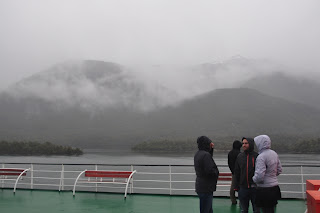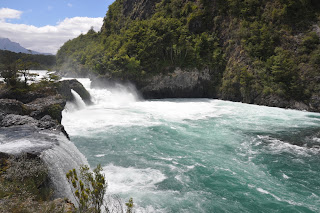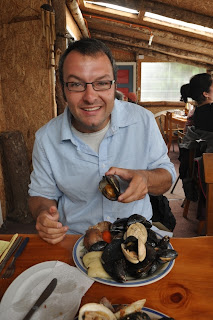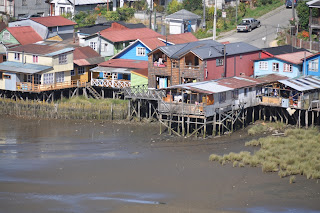We boarded the Navimag ferry on January 30 and shared a cabin with Mike and Kat for a 4 night day ferry ride from Puerto Natales to Puerto Montt. The ferry goes through the Chilean fjords and islands, which are almost impossible to get to any other way. It is a cargo ferry with room for 360 guests. It was not anywhere near as nice as the MS Expedition but it was about a tenth the cost as well. The food was fine and the views pretty nice. We spent the time playing cards, having some beers, watching out the window and playing dancing bingo. A pretty relaxing way to spend some time really. Chilean Patagonia is much wetter than Argentina and is much greener as a result. It reminded us a lot of coastal BC and the ferry from Port Hardy to Prince Rupert. Pretty wild that we met someone who I had met in Tuktoyaktuk 7 years ago. Her father used to work for the same company in Inuvik. That was the second person from the north I´d bumped into in a week - on the trails in Torres del Paine we ran into a guy from Yellowknife I see at conferences and meetings from time to time.
 |
| Another glacier that produced some ice for our drinks at the bar... |
 |
| ...transported via this zodiac. |
 |
| Elise and the Aussies on deck. |
 |
| It is much greener in Chilean Patagonia than across the border. |
Right away after getting to Puerto Montt the four of us took a bus to Puerto Varas. It is a pretty, small city. We toured the town a bit, took a bus into a nearby park where we saw some waterfalls and a lake surrounded by volcanoes, went whitewater rafting for a couple of hours (this time much better and warmer than near Mendoza, class III-IV - no pictures though) and caught the superbowl Chilean style. In Chile it is still allowed to smoke in public places, includng all the bars, so we usually smelt like an ashtray when we came back to bed. The aussies were not impressed with the game.
 |
| Falls on the Petrohue River near Puerto Varas. |
 |
| The view of the Osorno volcanoe from Puerto Varas. |
The four of us then rented a car in Puerto Varas and took off for a night to visit the island of Chiloe. Chiloe is South America´s second biggest island (after Tierra del Fuego) with a different culture than Chile which is maintained. We took a 30 minute ferry (saw lots of seals), had a traditional meal called ´Curanto´ (seafood, chicken, sausage and potatoes cooked under leaves in the ground), went to the coast to see Humboldt Penguins (not very close), stayed the night in a town called Castro (where we ate the biggest sandwhich I´ve ever seen) and spent the following day driving around to see various UN world heritage site churches. All the while terrified because aussie Mike was driving on the wrong side of the road for the first time in his life. The countryside again was really green with lots of fields of cows and nice farms. It wasn´t the most exciting two days but was really pleasant. After that Elise and I headed east back into Argentina to meet with a friend from Buenos Aires at his place in the mountains. Mike and Kat headed north. It was really great traveling with them, lots of fun.
 |
| That´s the biggest clam I´ve ever seen. |
 |
| A UNESCO world heritage church, one of 16 on the island. |
 |
| Traditional houses built to allow fishing boats to come right up at high tide. |
